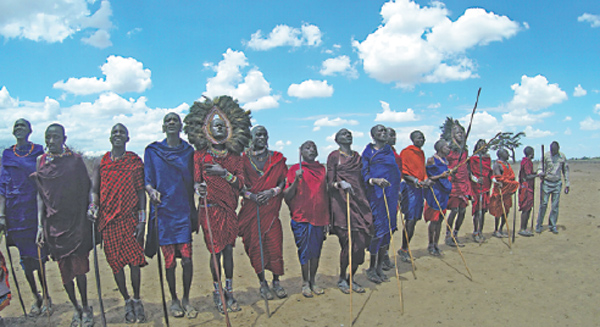Villagers not only bridge cultures, they oversee park conservation
By Chen Liang in Nairobi (China Daily) Updated: 2015-12-03 07:52
 |
|
Residents of Olasiti village, Kenya, have been protecting wildlife as well as performing for tourists and using the money they earned for community school operations. CHEN LIANG/CHINA DAILY |
Shadrack Kapaito stood in the shade of the only tall tree outside Olasiti village, near Kenya's Amboseli National Park, and waited to greet his special guests.
Kapaito, a member of the Maasai ethnic group, was wrapped in a piece of red shuka cloth and wore shoes made from rubber tires.
On the open ground not far from the tree, other villagers were dancing and singing, staging a traditional Maasai welcoming ceremony for a group of Western tourists.
When the dance ended, they entered the village, which was enclosed by a circular fence built from thorny acacia trees, forming a line with men at the front and women at the back, followed closely by the visitors.
As the son of the village head, Kapaito was chosen to receive a group of special guests, members of the China-Africa Wildlife Ambassadors initiative, which was launched by a wildlife conservation NGO, the International Fund for Animal Welfare, on Nov 12.
As the guests arrived, Kapaito began introducing Maasai culture, from social organization and music and dance to diet and architecture. What really surprised the visitors, however, was the fact that their host was already familiar with Chinese tourists.
"So far this year, we have received 200 Chinese visitors. They have brought us income of about 500,000 Kenyan shillings ($4,900)," the 40-year-old said, adding that the village hosted more than 200 Chinese tourists last year, along with about 150 visitors from other countries.
Each tourist pays $20 for the performance and a guided tour of the village, and they can also buy souvenirs. Visitors can donate to the upkeep of a community school, where three teachers work with 150 students from Olasiti and neighboring villages. The money donated by tourists helps to pay the teachers' salaries.
"We hope more Chinese tourists will come, and I want to learn to speak a little Chinese," Kapaito said in fluent English.
The 400 residents own about 500 cows, roughly half the number of just two years ago, before many died as a result of serious drought and famine, he said.
At present, 60 men from the community are working as temporary wildlife protection rangers, and the 15,000 shillings they earn every month is often paid by conservation organizations such as the IFAW, which runs a community conservation project.
"We don't have a problem with the wildlife living in the area," Kapaito said. If a cow is killed by a lion, the owner of the cow can receive compensation of 20,000 shillings, even though a cow is usually priced at 80,000 on the open market.
The 390-square-kilometer Amboseli National Park and surrounding area is home to 1,400 elephants, according to Evan Mkala, an IFAW project officer in Amboseli. Outside of the park, the elephants live alongside, and are cared for by, the Maasai, about 12,000 of whom live in and around the park and are a major conservation force.
"The Maasai people have a way of living with the animals. So when you come to Amboseli, you will see there is a harmony, a peace between human beings and wildlife. We don't need to put fences around the park," said Mkala.




